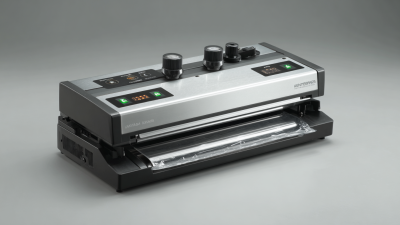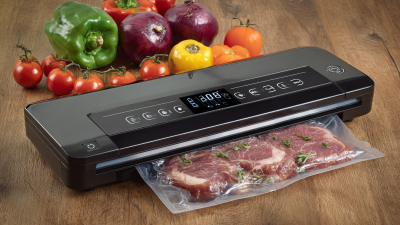About Us | Blog | FAQs | Tips/Troubleshoot | Contact Us | Machine Manuals | Demo Videos
Exploring the Benefits of Using a Chamber Sealer for Home Food Preservation
In recent years, home food preservation has gained significant traction as consumers seek to minimize waste and extend the shelf life of their groceries. According to the National Center for Home Food Preservation, nearly 61% of households in the United States engage in some form of food preservation, with vacuum sealing standing out as a particularly efficient method. A chamber sealer, in particular, offers an array of advantages over traditional vacuum sealing methods by providing a more consistent seal and allowing for the storage of liquids and moist foods without the risk of spoilage.

With the food waste problem becoming increasingly critical, as reported by the USDA, an estimated 30-40% of the food supply is wasted each year. A chamber sealer presents a practical solution for environmentally conscious consumers. By utilizing a chamber sealer, families can not only save money but also reduce their carbon footprint by preserving seasonal fruits and vegetables, meats, and leftovers effectively. This article explores the numerous benefits of using a chamber sealer for home food preservation, highlighting its efficiency, versatility, and the significant impact it can have on both household sustainability and food management practices.
Table of Contents
[Hide]
Understanding the Basics of Chamber Sealers and Their Functionality
Chamber sealers have become an essential tool for home food preservation, offering a superior alternative to traditional vacuum sealers. Understanding their functionality helps homeowners appreciate the unique advantages they present. Unlike regular vacuum sealers that just remove air from bags, chamber sealers remove air from the entire chamber containing both the bag and its contents. This method not only creates a more reliable seal but also reduces the risk of crushing delicate items, making them ideal for a variety of foods, from meats to vegetables.
According to a report by the Food and Drug Administration (FDA), proper food storage can significantly extend the shelf life of various products. Foods sealed with a chamber sealer can last 3-5 times longer than those stored using conventional methods. Moreover, a study by the University of Florida’s Institute of Food and Agricultural Sciences indicates that vacuum sealing can help in reducing food waste by up to 50%, which is a critical factor given that the USDA reveals that approximately 30-40% of the food supply in the United States goes uneaten. Therefore, utilizing a chamber sealer not only enhances food longevity but also supports sustainable practices in home kitchens.
The Advantages of Vacuum Sealing for Food Preservation at Home
Vacuum sealing has become increasingly popular among home cooks and food enthusiasts, offering an efficient way to preserve food while maintaining its freshness. According to a report by the USDA, vacuum sealing can extend the shelf life of food by 1 to 3 years, compared to conventional storage methods. This extended preservation reduces food waste, which is a significant issue, as the USDA estimates that 30-40% of the food supply in the U.S. is wasted each year.
Another notable advantage of using a chamber sealer is its ability to protect food from freezer burn. The USDA states that vacuum sealing can prevent the formation of ice crystals that cause freezer burn, which detracts from the taste and texture of food. By creating an airtight seal, your meats, vegetables, and leftovers stay safe from air exposure, retaining their quality for much longer.
**Tips for Vacuum Sealing:**
1. **Pre-freeze delicate items:** To preserve the texture of soft foods like berries or cooked items, consider pre-freezing them for a couple of hours before vacuum sealing.
2. **Label your bags:** Always date and label your vacuum-sealed bags. This will help you keep track of what you have stored and ensure you use them before they expire.
3. **Choose the right bag:** Not all plastic bags are suitable for vacuum sealing. Opt for bags specifically designed for chamber sealers to avoid leaks and ensure optimal sealing.
Exploring the Benefits of Using a Chamber Sealer for Home Food Preservation
| Benefit | Description | Examples |
|---|---|---|
| Longer Shelf Life | Vacuum sealing removes air, reducing oxidation and spoilage. | Meats, cheese, and vegetables |
| Prevention of Freezer Burn | Sealing protects food from moisture loss and freezer burn. | Frozen fruits and meats |
| Space Saving | Flat vacuum sealed bags take up less space compared to traditional storage. | Organizing pantry items |
| Flavor Preservation | Sealing retains flavors and nutrients of the food. | Herbs and marinaded items |
| Marinade Infusion | Vacuum sealing allows for quicker marinade absorption. | Meats prepared for grilling |
Comparing Chamber Sealers with Other Food Preservation Methods
Chamber sealers have gained significant attention in the realm of home food preservation, particularly when compared to traditional methods such as vacuum sealers and canning. Unlike standard vacuum sealers that rely on air removal from bags, chamber sealers remove air from an entire chamber, allowing for more consistent sealing regardless of the food type. According to a report from the Food Marketing Institute, foods preserved with chamber sealers can last 2-5 times longer than items stored using conventional methods, thanks to reduced oxidation and moisture loss.
Moreover, the versatility of chamber sealers extends beyond just food storage. Research from the Institute of Food Technologists highlights that these devices can effectively seal liquids and moist foods without compromising the integrity of the seal, something that traditional vacuum sealers struggle with. This capability means that users can preserve a wider array of items, including soups, marinades, and even delicate fruits, enhancing the overall functionality of their food preservation efforts. As the demand for food preservation solutions increases, chamber sealers stand out as a powerful tool for households looking to extend the shelf life of their perishable goods.
How Chamber Sealers Can Extend Shelf Life and Reduce Waste
Chamber sealers have gained popularity in home kitchens for their ability to extend the shelf life of various foods significantly. According to a report by Food Safety and Inspection Service, properly vacuum-packed foods can last 2 to 5 times longer than those stored conventionally. This is primarily due to the reduced exposure to air, which minimizes oxidation and inhibits the growth of bacteria and mold. As a result, home cooks can enjoy their ingredients longer, leading to reduced spoilage and food waste.
Furthermore, studies from the National Institute of Health reveal that food waste is a major contributor to environmental issues, with approximately 30-40% of the food supply in the U.S. going uneaten. By utilizing a chamber sealer, households can better preserve leftovers and bulk purchases, leading not only to savings in grocery bills but also to a more sustainable lifestyle. When food is kept in optimal conditions, it remains fresher, which encourages consumers to cook and consume what they have on hand, ultimately contributing to a decrease in waste.
Best Practices for Using Chamber Sealers for Maximum Food Freshness
Using a chamber sealer can significantly enhance your food preservation efforts at home. These machines work by removing air from specially designed bags before sealing them shut, which minimizes oxidation and reduces the growth of spoilage organisms. According to a report by the Food Storage and Preservation Institute, foods sealed with a chamber vacuum can last 3 to 5 times longer than those stored in traditional methods. However, to achieve these impressive results, it is essential to follow best practices.
One crucial tip for maximizing food freshness is to ensure that the bags are not overfilled. Overstuffing can prevent a proper seal, leading to air pockets that compromise the vacuum. For optimal results, fill bags only to about two-thirds of their capacity. Additionally, pre-freezing items like soups or stews before sealing can prevent liquids from being sucked into the sealing machine, ensuring a tight seal and avoiding clogs.
Another best practice is to adjust the sealing time based on the type of food being preserved. Delicate items, such as berries, require a shorter sealing time to prevent being crushed, while tougher items like meat can benefit from a longer seal. The Food Safety and Inspection Service recommends considering these adjustments to ensure that each item maintains its integrity and freshness. Embracing these practices can lead to more efficient food preservation and less waste in your kitchen.
Related Posts
-

Unlocking the Secrets: Technical Specifications and How to Choose the Best Chamber Sealer for Your Business
-

5 Best Chamber Sealers for Ultimate Preservation Solutions
-

Ultimate Guide to Choosing the Best Industrial Vacuum Sealer Machine for Your Business
-

Advantages of Using an Industrial Vacuum Sealer Machine in Your Business Operations
-

The Ultimate Guide to Maximizing Freshness with an Industrial Vacuum Sealer
-

How to Choose the Best Food Vacuum Sealer for Your Kitchen Needs

